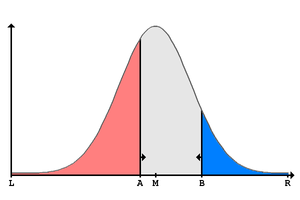Median voter theorem
The median voter theorem states that the parties' positions will ultimately align towards the center. The associated median voter model is used in the (new) political economy (economic theory of politics) to illustrate the behavior of parties .
Assumptions
To illustrate this, the model assumes a two-party system ; one party is classified as more on the left , the other as more on the right . For the sake of simplicity, it is also assumed that voters can be classified into two spectra in surveys, left and right. A continuous gradation is possible between an extreme left classification of a voter and an extreme right.
idea
Voters whose political and ideological views lie to the left of the left party will vote for the left party because it will better represent them. Conversely, voters whose views are to the right of the right-wing party will vote for the right-wing party. The two parties do not have to take these margins into account in their statements; they are already certain of the votes.
The median voter model therefore assumes that the positions of the political center are particularly competitive in the election campaign . If the left party moves closer to the right party programmatically, it can take away these votes. Conversely, the right-wing party will strive to move further to the left. There is a battle for the middle. The middle voter who determines the outcome of the election is called the median voter .
Formal definition of the median voter: The median voter is the voter who divides a frequency distribution into two groups of equal size.
|
The phenomenon is intensified under the assumption of an approximately normally distributed voter classification, as this means that a particularly large number of votes can be obtained in the middle.
Double median voter model
The model described can be expanded to the extent that left-wing parties tend to put up right-wing top candidates and, conversely, left-wing parties tend to put up left-wing parties. This promises a better chance of winning the median voter vote. Little attention has to be paid to the voters on the edge, as they will vote for the candidate who is closer to them anyway. Only the fight for the voters in the middle is therefore promising. Only these can be won through the election of the candidate.
In this way it can be explained why in social democratic parties candidates who often belong to the conservative wing prevail, while in conservative parties often candidates who belong to the social wing. The positions of the leading candidates are therefore often less far apart than the positions of the parties themselves. “Centripetal forces” of political competition are at work. These are forces that work towards the fact that the competing politicians or parties move towards one another.
history
The median voter model was first described in Duncan Black's 1948 article On the Rationale of Group Decision-making . It was spread primarily through Anthony Downs ' book An Economic Theory of Democracy (1957). However, the first approaches to the model can already be found in Condorcet (later generalized by Kenneth Arrow ) and specifically in 1929 in the article Stability in Competition by Harold Hotelling . For this reason, the median voter model is sometimes called the Hotelling Downs model .
rating
Occasionally it is criticized that the model can only be used directly in two-party cases. A reduction to “left” and “right” does not correspond to the political reality, in which a distinction can be made between socially liberal and socially conservative, economically liberal and regulation-friendly, ecology-friendly and technology-friendly and many other positions.
However, at least analytically, this is not a problem, since the other positions of the parties can be plotted on other dimensions of the coordinate system. For example, one would then get a two-dimensional coordinate system with the axis environmentally friendly-ecologically hostile, in which in principle the same considerations are possible. Multi-dimensional (especially more than three-dimensional) coordinate systems are less easy to represent graphically, but they also explain the facts.
Conclusion
Despite the simplified assumptions of the model, decisive explanations for the behavior of parties in a political system can be obtained on its basis. This is especially true for two-party systems . The model's predictions can often be observed in such systems, for example in election campaigns in the USA .
But the model can in principle be extended to multi-party systems, such as Germany . This is also because, even in multi-party systems, there is often only a choice from two political camps, or this impression is conveyed by polarization in the election campaign. Experience has shown that the neglect of wings can lead to parties splitting off or being founded, either because problem areas have been neglected ( social policy → social parties, ecology → environmental parties, freedom of information → data protection parties ) or ideologies have not been further served. This applies, for example, when parties align their positions too much in the middle and neglect the margins. In this way, a two-party system can expand into a multi-party system .
literature
- Roger Congleton: The Median Voter Model . (PDF; 181 kB). In: RK Rowley, F. Schneider (Eds.): The Encyclopedia of Public Choice. 2002, ISBN 0-7923-8607-8 .
- Elisabeth R. Gerber, Jeffrey B. Lewis: Beyond the Median: Voter Preferences, District Heterogeneity, and Political Representation. In: Journal of Political Economy. 112 (6), 2004, pp. 1364-1383. doi: 10.1086 / 424737
- Anthony Downs : An Economic Theory of Democracy. New York 1957. (German: Economic Theory of Democracy. Tübingen 1968)
- David Stadelmann, Marco Portmann, Reiner Eichenberger: Evaluating the median voter model's explanatory power. In: Economics Letters. 114 (3), 2012, pp. 312-314. doi: 10.1016 / j.econlet.2011
See also
Individual evidence
- ↑ Guy Kirsch: New Political Economy . Ed .: Guy Kirsch. 5th edition. UVK Lucius, ISBN 978-3-8385-8272-6 , p. 261 .




